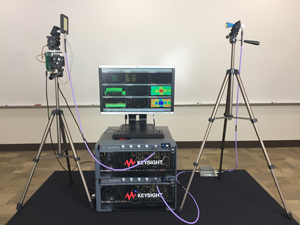Keysight Technologies, Inc. and the University of California San Diego announced the world’s fastest bidirectional phased-array link in the 28 GHz 5G band. The achievement is an important milestone for delivering future applications in 5G, aerospace and defense.
The demonstration included a 64-element array that achieved a data rate of 12 Gbps at 0 degrees and more than 8 Gbps over all scan angles up to ±50 degrees in azimuth and +/-25 degrees in elevation at a link distance of 300 meters. The array produced data rates of up to 18 Gbps at shorter distances. The bit-error-rate was less than 10 to 7 at maximum scan angles. The results did not rely on any calibration on the 64-element phased-array, thereby greatly reducing implementation costs.
The 64-element phased array, built on a low-cost printed-circuit board, only consumed approximately 7 to 11 W of DC power in either its transmit (Tx) or receive (Rx) modes thanks to the UC San Diego high-performance system-on-a-chip (SoC) designs that uses a third-generation silicon germanium (SiGe BiCMOS SBC18H3) process from TowerJazz.
UC San Diego used Keysight’s Signal Studio software to define and generate the 16-QAM and 64-QAM waveforms, with single and multiple carriers. Keysight’s 81199A Wideband Waveform Center software helped the team link the Tx and Rx units as well as improve the error vector magnitude (EVM) performance. The team also used Keysight’s 89600 VSA software to perform demodulation, channel equalization and analysis of advanced signals.
Keysight’s M8195A arbitrary waveform generator, E8267D PSG vector signal generator and DSOS804A high-definition oscilloscope enabled rapid prototyping as well as link equalization and state-of-the-art performance measurements across modulation bandwidths of up to 3 GHz frequencies was used.
“The results of our continuing collaboration with UC San Diego and the demonstrated advances in mmWave technology provide critical proof of viability for 5G, especially in the fixed-broadband use case, which many pre-standardization efforts focus on,” said Dr. Mark Pierpoint, vice president and general manager, Keysight Internet Infrastructure Solutions. “We are continuing to invest to create innovative solutions that enhance and accelerate the development of next-generation wireless communications.”
“UC San Diego has once again worked with Keysight to demonstrate high-performance phased-array 5G communication links, now achieving 8 to 12 Gbps links at long ranges and with low power consumption,” said Gabriel M. Rebeiz, member of the U.S. National Academy of Engineering, distinguished professor and wireless communications industry chair at the UC San Diego Jacobs School of Engineering. “Keysight’s equipment and software, along with the SBC18H3 technology from TowerJazz, have been instrumental to our success.”

